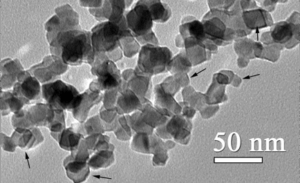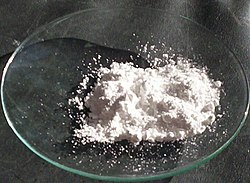
Titanium dioxide appears in many foods and some medicines (e.g., Allegra), in order to make colors and whites look brighter. In other words, it is an unnecessary food additive, found in a large variety of (ultra-processed) foods, including some candies, gum, frosting, soups, and even macaroni and cheese. It is allowed in the US (in over 11,000 food products!), but banned in Europe due to its harmful health effects.
A number of studies have linked titanium dioxide in its small nanoparticle form (between 1 and 100 nanometers) with a number of health harms, including to the gut (intestines). A recent study found that nanoparticle titanium dioxide has harmful or disruptive effects on the intestinal endocrine (hormone) system, resulting in abnormal blood sugar (glucose) levels, which can lead to insulin resistance and diabetes. It also caused intestinal lining changes, reduced levels of gut hormones, and resulted in a drop in enteroendocrine cells

While the study was done in mice, the results are also thought to apply to humans. The study didn't find the same health harms from larger titanium dioxide particles called microparticles (about the size of a fine grain of sand), but only from the nanoparticles. The problem is that nanoparticles are so small that once ingested, they get into cells and tissues throughout the body. However, large particles can be excreted from the body.
Bottom line: Unfortunately, it's the small nanoparticles that are so common in foods that we ingest. Read labels carefully and try to avoid those with titanium dioxide or artificial colors (includes titanium dioxide).
Excerpts from two informative articles: 1) From investigative journalism site US Right to Know: Tiny titanium dioxide particles in food raise blood sugar, disrupt gut hormones in mice, study finds
The study, published this month [May 2025] in Food and Chemical Toxicology, adds to growing concerns over the safety of titanium dioxide (TiO₂), a widely used color additive that is banned in the EU but widely used in the U.S. and elsewhere. It also highlights the food industry’s increasing use of microscopic materials to preserve or enhance foods.
Titanium dioxide nanoparticles (TiO2 NPs) are ultrafine particles between one and 100 nanometers. By comparison, a sheet of paper is about 1,000 nanometers thick. Unlike larger TiO2 microparticles, nanoparticles may act as intestinal endocrine disruptors, the researchers suggest.
The nanoparticles appear to interfere with how the gut senses nutrients from food in the body, and how it produces and releases key hormones involved in digestion and blood sugar level control (glucose homeostasis). When the body can’t control blood sugar properly, it can lead to type 2 diabetes and obesity by making it harder to use insulin and easier to store fat.
The findings reinforce earlier studies suggesting that TiO₂ nanoparticles may pose different—and in some instances, greater—health risks than microparticles. MPs are roughly up to 10 times larger but still only about the size of a fine grain of sand.
2) From The Guardian: Food additive titanium dioxide likely has more toxic effects than thought, study finds
The controversial food additive titanium dioxide likely has more toxic effects than previously thought, new peer-reviewed research shows, adding to growing evidence that unregulated nanoparticles used throughout the food system present an underestimated danger to consumers.
In nanoparticle form, titanium dioxide may throw off the body’s endocrine system by disrupting hormonal response to food and dysregulating blood sugar levels, which can lead to diabetes, obesity and other health problems, the study found.
The EU banned titanium dioxide for food use in 2022 because previous research has shown it to likely be a neurotoxin, be an immunotoxin, cause intestinal lesions and potentially damage genes. The particles can accumulate in organs and stay in the body for years.
The new research compared the gut health of three groups: mice that were fed titanium dioxide nanoparticles, mice that were fed larger microparticles and mice that were fed no titanium dioxide. Mice that were fed the nanoparticles showed lower levels of several types of gut hormones that signal to the body that it is full, aid in digestion and regulate glucose.
The mice that were fed the nanoparticles showed much higher levels of glucose, or blood sugar, than those that were fed microparticles. The authors also noted that “gut hormones secreted by enteroendocrine cells play a critical role regulating energy intake and maintaining glucose” levels. The titanium dioxide nanoparticles seemed to disrupt the enteroendocrine cells’ differentiation, which is part of the hormone secretion process, and reduce the cells’ numbers.
